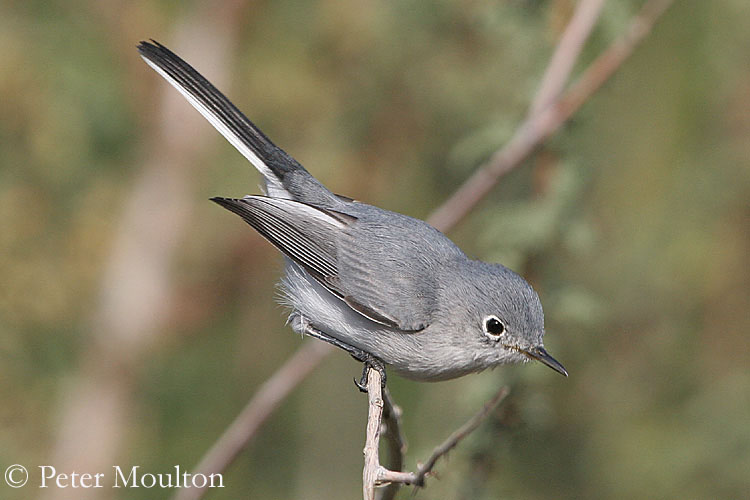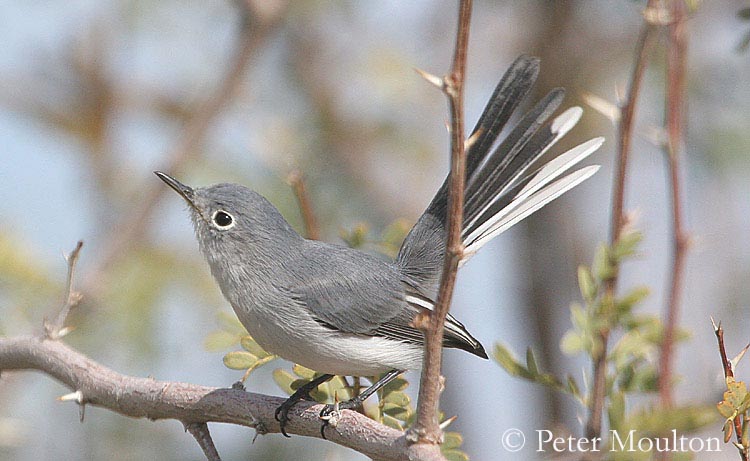
Blue-grey Gnatcatcher
Polioptila caerulea
Passeriforme Order - Polioptilidae Family
BIOMETRICS:
Length: 10 à 11 cm ; Wingspan: 16 cm ; Weight: 5-7 g
LONGEVITY: up to 4 years
DESCRIPTION:
Blue-grey Gnatcatcher has blue-grey upperparts. Long tail is dark grey to black, with white edges on outer feathers. Wings are sooty dark blue with dark tips.
Underparts are whitish. Sides and undertail coverts are light grey.
Crown is blue-grey. In breeding plumage, the forehead is black, extending in a black line above and behind the eyes. It has a conspicuous white eye ring. Chin and throat are white.
Black bill is small, thin and pointed. Eyes are dark brown. Legs and feet are blackish.
Female is greyer, duller than male.
Juvenile resembles female, with wings slightly browner.

VOICE: SOUNDS BY XENO-CANTO
Blue-grey Gnatcatcher’s call is a thin, nasal “pwee”. Song is soft and musical, a low-pitched trilling “zee-you-zee-you”, and a light buzz “pzzzz”. This song may contain some mimicry of other species’ songs.
Both sexes utter a kind of two-note mewing call, maybe as alarm call.
HABITAT:
Blue-grey Gnatcatcher lives in deciduous woodlands, thickets near water and chaparral. They concentrate along habitat edges.
RANGE:
Blue-grey Gnatcatcher breeds in North America, from southern Canada, to Guatemala and Cuba. It winters from southern South Carolina, along Atlantic coast, and southern Mississippi and Texas, to Central and South America.
BEHAVIOUR:
Blue-grey Gnatcatcher gleans off foliage, searching for insects. It searches for food, moving up and down into foliage in trees and shrubs. It may catch them on the wing, or by hovering. It hops from place to place on ground or branches. It flicks its tail continuously, which may flush prey. It removes the wings of the large insects and beats the large preys against a perch, before to swallow it.

DIET:
Blue-grey Gnatcatcher feeds on small insects and spiders.
PROTECTION / THREATS / STATUS:
Blue-grey Gnatcatcher may be parasitized by Brown-headed Cowbird. Populations however appear to be increasing since the last 25 years.
Fr: Gobemoucheron gris-bleu
All : Blaumückenfänger
Esp : Perlita Común
Ital : Zanzariere blue-grigio
Nd : Blauwgrijze Muggenvanger
Sd : Blagra myggsnappare
Photographs by Pete Moulton
His website : Pete Moulton Photography
Texte de Nicole Bouglouan
Sources:
HANDBOOK OF THE BIRDS OF THE WORLD Vol 11 by Josep del Hoyo, Andrew Elliott and David Christie - Lynx Edicions - ISBN: 849655306X
FIELD GUIDE TO THE BIRDS OF NORTH AMERICA by National Geographic Society - National Geographic Society - ISBN: 0792274512
All About Birds (Cornell Lab of Ornithology)
Animal Diversity Web (University of Michigan Museum of Zoology)
Wikipedia (Wikipedia, The Free Encyclopedia)
Blue-grey Gnatcatcher is very territorial, very active and aggressive. It performs some displays, with raised tail and bill clapping, towards intruders. When the second brood is started, parents may attack the young from the first clutch if they interfere.
Pairs are monogamous and formed on the breeding areas. They seem to have no well-marked courtship displays. Male often fights with others, and gives its songs and chattering.
Blue-grey Gnatcatcher is migratory.
FLIGHT:
Blue-grey Gnatcatcher performs short moth-like flights, and weak fluttering flight with shallow wing beats.
REPRODUCTION:
Blue-grey Gnatcatcher’s nest is fastened to a horizontal branch, from 60 cm to 7 metres above the ground. Nest is built by both adults in a fork. It is a very beautiful small cup with high rims, made with plant down, spider webs and caterpillar silk, and covered with small pieces of lichens or bark. Pair needs about four days to build it.
Female lays 4 to 5 pale blue eggs, spotted with brown. Incubation lasts about 13 days, by both parents. Chicks hatch altricial. Both adults brood them at nest and feed the young. They fledge at about 10 to 12 days of age. Adults feed them during about three weeks more.
This species produces one brood per season, two in the southern parts of their range.